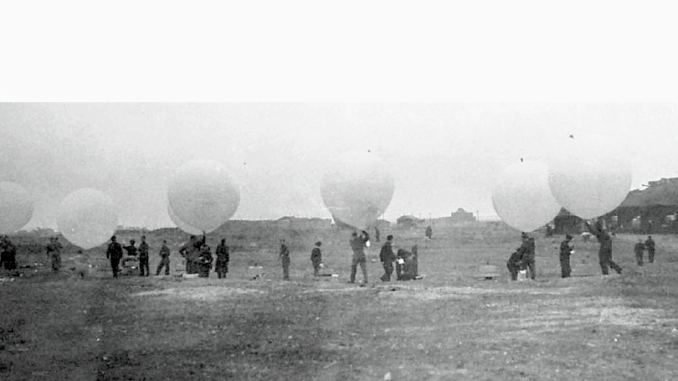
By early September 1940, the Battle of Britain had been raging for nearly two months in the Lufwaffe’s attempt to completely destroy the RAF. Failing that, on the seventh of September the Germans altered strategy, shifting their focus from targeting the RAF to bombing industry and civilian populations. Barrage balloons, which resembled small blimps, were an important part of British air defenses against the bombers. However, a fact of life with barrage balloons was that it was impossible to keep them from breaking free from their moorings in very high winds. Although the cables tethering the balloons to the ground were steel, nature could always find a weak point to break.
Ten days after the Blitz began, a severe overnight storm broke several barrage balloons free, which were swept west across the North Sea, their steel cables still attached. These slowly drifted down to Earth as the balloons reached Scandanavia. In Denmark and Sweden, the ballons found electric power lines to drape their cables over, causing large-scale short circuiting. At least one radio transmission tower was knocked over in Sweden by a balloon. News of the accidental damage reached Britain shortly thereafter, and Churchill ordered the Admiralty and the Air Ministry to look into the possibility of purposely letting balloons loose on Germany. Possibly because roaming balloons could become a hazard for RAF aircraft, the Air Ministry was critical of the idea. The Admiralty, in contrast, was an enthusiastic supporter of the plan. Thus it fell to the Royal Navy to implement, primarily by the Women’s Royal Naval Service (WRNS, pronounced wrens). Operation Outward launched the first balloon on 20 March 1942, continuing until the last balloon was released on 4 September 1944, for a total of 99,142 balloons.
Fortuitously, the Navy already had 100,000 latex weather balloons (of 8 foot diameter) in storage. There was also plently of hydrogen gas available to fill the balloons, and any other components needed could be sourced from surplus equipment. Each balloon cost the Navy less than 35 shillings (about £96 today), so they were extremely cost effective.
Roughly 55% of the Outward balloons launched between 1942 and 1944 trailed a wire which, it was hoped, would cause a short between different phases of power lines. A short between phases on a two phase or three phase high-voltage transmission trunk caused a great deal more damage than a short between any power line and ground. Many shorts were incurred, often causing interruptions in electric service which in turn hampered German war factory production. The British were able to confirm that manpower was diverted away from Germany’s war effort in order to deal with damage caused by the balloons. Better still, the Luftwaffe devoted considerable time and resources looking for balloons to shoot down before they could do any damage. A distracted Luftwaffe was a welcome benefit for Britain and the Allies. In the most dramatic attack, a balloon-caused short in the vicinity of Leipzig started a fire at the Böhlen power station resulting in the complete destruction of the power plant.
Close to 45% of Operation Outward’s balloons carried incendiaries intended to start fires to farms and forests. The British found evidence that these, too, diverted manpower and resources away from the German war effort, although post-war German documentation to confirm this was much harder to come by. Several hundred other balloons may have been used to disperse propaganda leaflets, however in this instance it’s British documentation that’s a bit sketchy.
Operation Outward remained classified and little known after the war until the 1980s, probably out of Cold War fears. In retrospect, it appears to have been an highly successful effort, with alot of bang for the buck.
